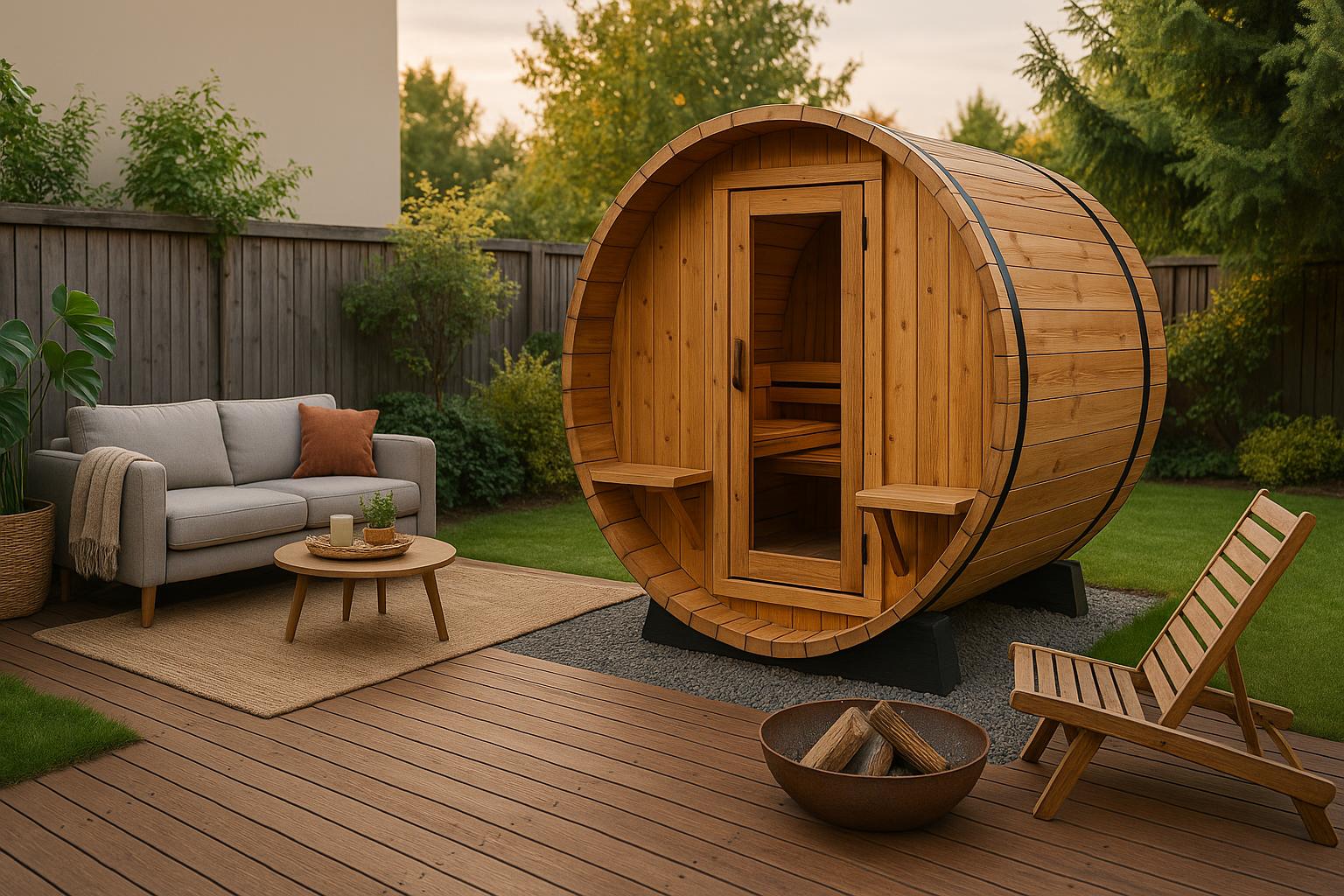
Transform Your Living Space: The Ultimate Guide to a Tiny Home Sauna in Canada
Estimated reading time: 10 minutes
Key Takeaways
- Tiny home saunas offer an innovative approach to wellness in compact living environments.
- Space efficiency is maximized with portable, barrel, and compact cabin models, ideal for Canada’s diverse climates.
- Installation and design tips emphasize proper insulation, ventilation, moisture management, and compliance with local safety codes.
- Integrating wellness rituals such as sauna sessions, cold plunges, meditation, and yoga can enhance recovery and stress relief.
- Local sourcing of materials like cedar and hemlock supports durability in harsh winters and promotes Canadian suppliers.
Table of Contents
- Introduction: Tiny Home Sauna and Wellness in Small Space Living in Canada
- Why Choose a Tiny Home Sauna? Wellness and Canadian Cultural Appeal
- Understanding the Space Constraints: Tiny Home Sauna Design for Small Space in Canada
- Step-by-Step Guide to Adding a Tiny Home Sauna in Canada
- Incorporating Wellness and Health Trends
- Maintaining Your Tiny Home Sauna for Longevity
- Conclusion
- Frequently Asked Questions
Introduction: Tiny Home Sauna and Wellness in Small Space Living in Canada
A tiny home sauna is making waves among Canadian homeowners looking to bring spa-like wellness into limited living spaces. As the tiny home lifestyle and accessory dwelling units (ADUs) gain popularity, wellness features that maximize comfort and support healthy living are becoming essential—even in the most compact of spaces.
From stretching out after a cold commute to carving out a daily self-care routine, Canadians are pioneering the blend of wellness, smart design, and efficient small space living. Regular sauna use offers benefits such as detoxification, stress relief, and improved cardiovascular performance. Learn more about these benefits from this resource and this guide.
In Canada, a tiny home sauna is more than a passing trend—it’s a gateway to relaxation, improved well-being, and smarter use of space in an evolving living environment.
Why Choose a Tiny Home Sauna? Wellness and Canadian Cultural Appeal
Defining a Tiny Home Sauna and Its Value
Unlike traditional, large-scale saunas, a tiny home sauna is designed to support small space living without sacrificing therapeutic benefits. Perfect for tiny homes, cabins, or ADUs, these compact units offer all the heat and benefits of a full sauna experience.
How Tiny Home Saunas Boost Wellness
- Detoxification: Sweating helps eliminate toxins accumulated over time.
- Stress Relief: Heat aids in reducing tension and facilitates muscle repair.
- Improved Circulation: Warming the body promotes healthy blood flow and cardiovascular health.
- Muscle Recovery: Ideal for athletes and active individuals to speed up recovery.
- Immune Support: Regular sessions can potentially enhance immune function, as detailed here and here.
Space Efficiency for Small Living
Modern tiny home saunas are designed with space efficiency in mind:
- Portability: Portable infrared or compact wood/electric units can be easily relocated.
- Easy Integration: They’re built to slot into corners, closets, or outdoor decks, making them perfect for compact setups.
Canadian Culture and Sauna Traditions
With long Canadian winters, a sauna is a traditional method for staying warm and relaxing. Influences from Scandinavian and Finnish traditions, along with Indigenous practices, underline the cultural significance and wellness benefits of sauna use.
Explore more about the tradition and design of these saunas at this source and this guide.
Understanding the Space Constraints: Tiny Home Sauna Design for Small Space in Canada
Assessing Space for a Sauna in Your Tiny Home or ADU
Before installing a tiny home sauna, careful planning is essential. From mapping out available floor area to identifying optimal spots with access to electrical outlets and ventilation, every inch counts.
Key Recommendations for Maximizing Space:
-
Measure Carefully:
- Map out your available floor area.
- Prioritize areas near utilities and windows.
-
Identify Possible Locations:
- Indoor options include corners, closets, or under stairs.
- Outdoor placements might be on decks or in unused garden areas.
-
Maximize Functionality:
- Opt for foldable or portable models for flexibility.
- Choose custom-built or prefabricated units such as barrel saunas to save space and enhance heat retention.
Explore detailed design ideas at this guide and this resource. For further inspiration on small space living, check out Tiny Home Living: Your Complete Guide to Micro Homes, Sustainability, and Lifestyle Freedom and Small Homes: Compact Living and Efficient Home Design for Stylish and Functional Urban Spaces.
Step-by-Step Guide to Adding a Tiny Home Sauna in Canada
Planning Your Tiny Home Sauna Project
Begin by assessing available space and choosing between an indoor or outdoor installation based on climate, utility access, and privacy. Ensuring that electrical and ventilation requirements are met will prevent any costly mistakes later on.
For more on planning efficient small spaces, refer to Tiny Home Living: The Ultimate Guide to Affordable, Sustainable, and Stylish Compact Living.
Selecting the Type of Sauna: Infrared, Electric, or Wood-Burning
The sauna type you choose will depend on your specific needs and the available resources:
Infrared Sauna
- Definition: Uses infrared panels to heat the body directly at a lower air temperature.
- Benefits:
- Energy efficient and quick to assemble.
- Ideal for urban homes and ADUs with limited space.
- Supporting Research: Learn more from this source and this guide.
Electric Sauna
- Definition: Uses an electric heater to warm the air, providing consistent heat.
- Benefits: Reliable performance and ideal for both indoor and outdoor settings.
Wood-Burning Sauna
- Definition: Employs a wood stove to generate heat and offers a traditional sauna experience.
- Benefits: Provides a rustic charm and is ideal for outdoor, rural settings.
- Considerations: Must adhere to fire codes and require proper ventilation.
Sourcing Materials and Suppliers
For a durable tiny home sauna, choose premium, locally sourced materials:
- Canadian-Sourced Woods: Cedar and Hemlock are excellent for their durability and insulation properties.
- Certifications: Check for CE or ETL marks on kits and electrical components.
- Local Suppliers: Buying local supports the Canadian economy and ensures materials suitable for harsh winters.
More insights can be found at this resource and How to Choose a Reliable Tiny Home Builder Canada: Expert Hiring Advice and Construction Tips for Your Project.
Installation Tips for Your Tiny Home Sauna
- Proper Insulation: Use tongue-and-groove paneling and proper insulation on floors, ceilings, and walls.
- Ventilation: Ensure adjustable vents or windows are in place to maintain air flow and prevent overheating.
- Moisture Barriers: Install vapor barriers to protect adjacent structures from moisture damage.
- Safety Codes: Engage certified electricians and secure all necessary permits.
For additional installation tips, see Tiny Home Design in Canada: Expert Tips for Maximizing Small Living Spaces.
Permitting and Regulations
Prior to installation, check with local municipalities to ensure compliance with building codes, zoning laws, and fire regulations. This is especially critical for wood-burning saunas and outdoor installations.
Consult Canadian ADU Regulations: A Comprehensive Provincial Guide to Secondary Suites, Zoning Laws, and Building Permits for a detailed overview.
Incorporating Wellness and Health Trends: How a Tiny Home Sauna Supports Modern Living
Modern wellness trends place great emphasis on integrating self-care and holistic practices into everyday life. A tiny home sauna fits seamlessly into this trend by combining the benefits of detoxification, stress relief, and improved circulation.
Key Wellness Benefits
- Detoxification: Sweating helps cleanse the body of impurities.
- Stress Relief: The calming heat reduces cortisol levels and relaxes muscles.
- Improved Circulation: Heat boosts blood flow, aiding in muscle recovery and overall healing.
For more information on sauna benefits, visit this resource and this guide.
Enhance your wellness routine with complementary practices such as cold plunges, yoga, and meditation to further boost circulation and mental clarity.
Maintaining Your Tiny Home Sauna for Small Space Longevity in Canada
Long-term enjoyment of your tiny home sauna depends on regular maintenance and smart upkeep:
Moisture Management
- Ensure continuous airflow by leaving doors and vents open after use.
- Consider installing a small exhaust fan in tightly enclosed areas.
- Utilize moisture-resistant woods like cedar to fend off mold growth.
Regular Cleaning and Safety Checks
- Wipe down surfaces with a damp cloth and let the sauna dry completely.
- Inspect heaters, wiring, and structural integrity at least biannually.
- Re-oil wooden surfaces every six months to maintain their natural resilience.
Further cleaning tips can be found here.
Conclusion: The Lasting Impact of a Tiny Home Sauna on Wellness and Small Space Living in Canada
Transforming even the smallest home with a tiny home sauna can unlock profound wellness benefits. With daily routines that support stress relief, detoxification, and improved circulation, you can elevate both your physical and mental well-being.
Embrace the fusion of tradition and modern design—integrate a sauna into your tiny home or ADU, and enjoy a piece of Canadian cultural heritage. Whether it’s for health benefits, space efficiency, or fostering a sense of community, a tiny home sauna offers lasting value for every Canadian household.
For additional inspiration, visit this resource, this guide, and this overview.
Frequently Asked Questions
1. What should I consider when planning a tiny home sauna?
You should analyze the available space, ensure proper access to utilities, and consider insulation and ventilation. Proper planning is essential for both indoor and outdoor installations.
2. Which type of sauna is best for compact living spaces?
Infrared saunas are often favored for small spaces due to their energy efficiency and ease of installation. However, electric and wood-burning saunas offer different aesthetic and functional benefits depending on your needs.
3. How do I maintain my sauna in harsh Canadian winters?
Regular cleaning, moisture management, and periodic maintenance such as re-oiling wooden surfaces are key. Ensure proper insulation and ventilation to keep your sauna functioning efficiently even in extreme weather.
4. Can I install a tiny home sauna myself or should I hire professionals?
While small sauna kits are designed for ease of assembly, it is recommended to consult with or hire certified professionals—especially for electrical work and structural modifications—to ensure safety and compliance with local codes.
5. Where can I find additional resources for designing and building my tiny home sauna?
Additional insights, design tips, and sourcing guides are available at this resource, this guide, and Tiny Home Living: The Ultimate Guide to Affordable, Sustainable, and Stylish Compact Living.

Leave a Reply